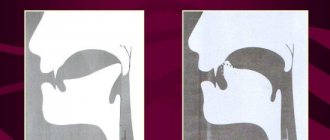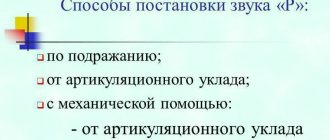Parents proudly call children with a throaty R sound “our Frenchwoman” or “our Frenchman.” Speech therapists call this phenomenon rotacism. In his article, Dial-Dent speech therapist T. B. Tsukor talks about the secrets and mysteries of the throat pronunciation of the sound R and answers the question of whether correction of the throat r is necessary.
The throat pronunciation of the sound P is perhaps the only variant of the distorted pronunciation of the sound P, which most parents accept as the norm, since it is closest in sound to the classics. Some parents even consider this method of pronunciation piquant. And who wants to part with the zest? Some enterprising parents find application for this method of pronunciation by sending their children to German and French schools. In all three cases, the throaty P is not subject to correction and is included in the structure of the phonetic representations of the child and then the adult. There remains a small part of parents, approximately 20 percent, for whom their child’s throat R hurts their hearing, and they still turn to a speech therapist to eliminate it.
Throat pronunciation of R, causes of occurrence
I would like to focus your attention on the causes of this speech defect. Why, being surrounded by a social environment where non-throat sounds are normative, did the child choose this particular method of pronunciation? So something contributed? What could it be?
- A short hyoid frenulum, which limits the mobility of the tongue and affects the bite.
- Chronically enlarged tonsils, which keep the area of the root of the tongue in an excited state, and it is easier for the child to make a bow with the back of the palate and the root of the tongue than with the front of the tongue with the anterior third of the palate.
- Hypotonicity or hypertonicity of the tongue, which, by the way, often reflects the situation in the body (you don’t know why your child is awkward, falls out of the blue, everything falls out of his hands, and it seems to you that this is absent-mindedness, but here you need the help of a massage therapist or osteopath).
- Impaired phonemic hearing, which should not be confused with physical hearing, and which will seriously affect the quality of education in the future. For example, a child writes instead of U-O, instead of B-P, does not add endings and/or misses letters in the middle of a word.
- A variant of organic damage, which, in addition to the sound R, will cause problems of a neurological nature: fears, fatigue, unreasonable mood swings, sensitivity to stuffiness and motion sickness in transport.
It is better to entrust an accurate diagnosis of the problem that led to the appearance of throaty pronunciation in a child to professionals. And you need to start with a consultation with a speech therapist. If necessary, he will refer you to other specialists, for example, a pediatric ENT specialist or a pediatric dentist. All the necessary specialists work at the Dial-Dent clinic.
Exercises
All you need to start with is warming up the articulatory apparatus. To do this, do exercises for the tongue, lips and the entire speech apparatus.
Articulation gymnastics
- “Pendulum”: the baby sticks out his tongue and moves it from the left corner of his mouth to the right.
- “Brush”: open your mouth as wide as possible and use your tongue, like a brush, to paint the palate from the front upper teeth and as deep as possible to the throat. Such “coloring” games can be played out by using a new imaginary color every day.
- “Mosquitoes”: the child opens his mouth and sticks the tip of his tongue behind his teeth, pronouncing a long sound z. Then the same is done, but the tongue must be moved to the palate, resting at the base of the upper teeth.
- “Accordion”: the baby smiles and opens his mouth wide. You need to rest your tongue on the roof of your mouth as if you want to pronounce the sound “n”. With this position of the tongue, alternately open your mouth very wide, then close it. Do 15-20 times. This exercise helps stretch the short frenulum.
Throat pronunciation of R, consequences
If you do not eliminate the throat P, then we have obvious and superficial consequences, as well as hidden ones associated with the causes described above.
The obvious disadvantages of throat P are the following. A person with throat P may not be “allowed” into a number of professions, for example, an actor or radio or television announcer. There may also be restrictions on professions in the “person-to-person” system (for example, teacher, kindergarten teacher, tour guide, lawyer, etc.). Work associated with significant neuropsychic stress, exposure to significant production noise, and the use of verbal signals will not be suitable. Alternatively, a person will choose a specialty in the field of “human-technology”, “human-sign system”, “human-creativity”, etc.
Unobvious consequences include malocclusion, the appearance of ENT problems, the child’s poor performance at school, etc. In these cases, throat P is more of a signal than a symptom, but, nevertheless, parents should be aware of it.
Consultation “14 ways to set sound [P]”
Yulia Smirnova
Consultation “14 ways to set sound [P]”
1 way to set sound [P]:
Staging [R] - quickly and efficiently. This method helps to quickly create vibration. The child puts his head on the speech therapist’s lap, sucks his tongue to the palate (“Mushroom”, at this time the speech therapist, with his thumb and forefinger (clean), presses the lateral edges of the tongue to the palate (not the tip, the child blows forcefully on the tongue and ... vibration often appears immediately !
2nd way to set sound [P]:
The child is asked to raise his wide tongue by the upper teeth and pronounce a sound similar to “zzh” for a long time (something in between these sounds is heard: [z] with the overtone [zh] or vice versa) or repeatedly pronounce the sound [d] (but the tongue is not teeth, but on the alveoli, so the sound [d] is not clear).
3rd way to set sound [P]:
Make sure your tongue is wide and very tense. At this time, with a straight (cleanly washed, with a short-cut nail so as not to scratch the tongue) index finger of the child himself or with your finger wrapped in a handkerchief, placed under the tip of the tongue, make frequent oscillatory movements from side to side, which is why a rumbling sound is heard. (You can use a pacifier tightly stuffed with cotton wool or make a plastic spatula from a toothbrush, removing the bristles to create a comfortable plastic stick; the corners must be rounded.) When the child’s hand gets used to it and the tongue does not slip off the finger (spatula), the baby will be able to cause vibrations of the tongue. If the tongue is not wide and not tense, the finger will carry it along with it and there will be no trembling. The tongue will swing along with the finger, with a sound close to “dl.” Pay special attention to the child that the tongue should be like staunch tin soldier and under no circumstances leave his post. You can compare the tongue to a string. If the string is tense, then by touching it we cause it to vibrate, the string begins to sound, but if the string is loosened, there will be no sound. This exercise is very children like it, and they do it with pleasure. The child can be told that you are now going to try to start the engine. Having achieved vibration of the tip of the tongue with mechanical assistance, the duration of vibration is lengthened and gradually moves to the fact that the child begins vibration with mechanical assistance, and continues without it . Over time, it is enough for the child to bring his finger to his mouth, and the tip of the tongue begins to vibrate on its own (the finger in this case serves as self-soothing, the child is not yet confident in his abilities, and gradually the need for this disappears. If independent vibration of the tip of the tongue is not produced for a very long time, they begin to automate the sound [r] in syllables and words, achieving a boom with mechanical assistance.
4th way to set sound [P]:
You can cause the tip of the tongue to vibrate in the following way: invite the baby to suck his tongue to the palate with his mouth open, then, without letting go of the tongue, blow on it. At the moment the tongue is lifted from the palate, a strong push of the exhaled stream of air causes a short vibration of the tip of the tongue. This exercise reinforces in the child the feeling of vibration of the tip of the tongue, and then he can cause this sound on his own, without mechanical assistance. The second version of the same method (with mechanical assistance). Raise your tongue to the sky, stretching the “frenulum” to the limit. Then, with your thumb and index finger, press the lateral edges of the tongue firmly against the palate. The middle part of the tongue and the frenulum should remain unclamped. Taking a deep breath, forcefully blow out the air while turning on your voice. The tongue “swells” and the sound combination “tzh” is heard (some children immediately get the combination “tr” (dr). The teeth in the exercise are open at a distance of one and a half to two fingers. Repeat the exercise many times, gradually increasing the air pressure. The sound combination “tzh” will gradually turn into “tr” (dr. Be sure to ensure that the tip of the tongue vibrates and is held against the palate, and the edges of the tongue are adjacent to the lateral edges of the upper teeth. Under the pressure of a strong stream of air, a short “tr-tr” is spontaneously produced (dr. There may be the following inaccuracies: the fingers grab the “frenulum”, and vibration does not occur when blowing air; the air does not pass along the tongue, but into the nose, so the tongue does not “swell” or “pop”; the stream of exhaled air is not strong enough; instead the sound combination “tr” (dr) is heard “tl”, this means that the tongue itself works voluntarily (work, that is, vibrate, the tongue should be under the pressure of a strong stream of air, the tongue should fit tightly to the palate and be motionless; one should refrain from making the sound [r] by imitation. When pronouncing a sound correctly, the tip of the tongue vibrates, and when imitation is incorrect, very often either the “tongue” or the root of the tongue in contact with the soft palate begins to vibrate. After consolidating the pronunciation of the short “tr” (dr), it is necessary to train the rolling long “tr” (dr) - first with the help of fingers, and then without fingers. There is no need to rush at any of these stages. A child may get a rolling r the first time, and it may take several months. The main task you face is to perform these exercises regularly, preferably every day. Having started staging [p] in one way, do not rush to be disappointed in it and move on to another. Please be patient with this work.
5th way to set sound [P]:
Setting from sound [Z]. Usually R is not placed from the sound Z, because it is believed that they are very different in articulation and cannot be a reference for each other. But you can try. The secret is that the child pronounces [Z] very briefly, only touching the alveoli with his tongue and at the same time blowing strongly on the tongue. At first, a single-strike [P] will be clearly heard, which then relatively easily turns into vibrant. This method is very easy and fast, especially with throat [P]. I wish you success in using it!
6th way to set sound [P]:
For progeny: press the tip of your tongue to the lower incisors and draw out the vowel “AAAAAA”, alternately opening and closing your mouth. With the mouth closed, the child will place the upper incisors on the tip of the tongue pressed against the lower incisors, i.e. the child will tap the top of the tongue. When classical techniques for setting [P] are not enough.
7th way to set sound [P]:
In especially persistent cases, when the classical methods of setting [P] are not enough, I use the following exercises - syllables that must be pronounced quickly and rhythmically: dydydydydydy....adydyadydy....tydydydydydy. dydadydadyda...adydaadadyda...youydydydydydy.... dydodydodydo... dydoadydo...
8 way to set sound [P]:
Games-exercises for evoking the sound [r]. The exercises are very simple and are well suited for training the raising of the tongue to the alveoli, and at the same time trains fine motor skills. a) Exercise “Happy Rain” Say firmly the sounds [etc]. Do you hear as if droplets are falling and hitting something hard? Place your left palm and show with your fingers how raindrops fall on your hand, slowly at first, and then faster and faster. The rain dripped onto the palm - t-d, t-d... (with your right hand, depict falling drops of rain) On the flower - t-d, t-d (with your left hand, depict a flower) And on the path, t-d, t-d... ( make a path from your left hand) He knocked on the roof - t-d, t-d…. And there was a frequent ringing - t-d, t-d, t-d (the rain started getting heavier). While playing, try to change hands and learn the rhyme by heart. We pronounce T-D exaggeratedly (emphasized). We exclude the work of the jaw. b) Exercise “Crocodile Gena’s Song” The melody of the song is well suited for training the raising of the tongue to the alveoli. At first we sing the song only on the syllable YES. In the future it will be useful to use the syllables DY, DE, DO, DU. You can alternate syllables, taking into account the child’s wishes. When fixing the sound [r], we sing a song on the syllable RA.
9 way to set sound [P]:
Setting [P[ from the interdental position. The “tongue on the upper lip” position and a directed air stream are first practiced. • Wide edge of the tongue on the upper lip. In this position, the child is asked to blow on the tip of his nose with a buzzing sound similar to “B-B-B.” • In addition to the previous position, the speech therapist uses his index finger to “play” on the child’s lower lip, as a result of which the air stream acquires a vibrating character. This effect needs to be worked out properly. Older children can be offered independent “performance” with a finger on the lip. • Then gradually reduce the duration of the finger touch, then removing it, then returning. Achieve a vibration sound from the slightest touch on the lower lip (something similar to “v-v-r-r-e-uh...”) • While maintaining the same configuration of the tongue, while the vibration sound is being developed, it is easy to move the tongue behind the upper teeth. It is important not to lose the shape of your tongue! This technique was taken from the arsenal of Irina Anatolyevna Smirnova, a speech therapist from St. Petersburg. She recommended it for children with dysarthria, since in this case the child does not require great muscle effort, and, therefore, the spasticity of the articulation organs does not increase.
10 way to set sound [P]:
Making the sound [P] while inhaling. The condition is the correct and clear pronunciation of the sound [C]. The child pronounces SSSSS for a long time, and then takes a short breath through his mouth, sharply raising and pressing his tongue to the alveoli, sucking the tongue “like a snail into a shell.” If the child does not touch the alveoli with his tongue when inhaling, then the sound will not be produced. The method is very unexpected, paradoxical (after all, all normal speech therapists make sounds “on exhalation”)
11th way to set sound [P]:
Setting the sound [P] from the “CHATTER” exercise. There is an interesting playful way of making the sound [P] from the “Chatterer” exercise, which is well known to children. The method is accessible to any beginning speech therapist. The child does the “Chatterer” (or “Turkey”) exercise: sticking out a wide tongue at the sound [A] makes movements back and forth, sliding along the hard palate. At the moment when the tongue touches the alveoli, a single-beat [P] is heard. Now all that remains is to fix this position and start automating [P]. As a rule, very soon the single-beat sound itself turns into vibrant (the tip of the tongue trembles).
12th way to set sound [P]:
Setting [P] from the sound [Zh]. Everything new is well forgotten old. The method of setting [P], which was actively used 30-40 years ago. All speech therapists love to evoke the sound [R] with the help of all kinds of vibrations (“motor” and the like). But there are children who are terrified of probes, sticks, pacifiers, teaspoons and other available means. The following method is very good for them: the child pronounces the sound [Zh], for a long time, on one exhalation and at the same time moves the tip of the tongue deeper into the oral cavity. A second later you can hear a single-beat [P]. After fixing the isolated pronunciation of this sound, they immediately move on to pronouncing syllables with a combination of TR, DR, NR, ZHR. This contributes to the rapid transfer of a single-beat [P] into a state of vibrating sound. The method justifies itself.
13th method of sound production [P]:
The method of producing the sound [P] is as old and simple as the world. It is performed in 3 steps: 1) suck the tongue to the hard palate (“Fungus”) 2) take a deep breath through the nose (tongue in the same position) 3) make a sharp short exhale through the mouth, directing the air stream to the tongue and connecting the voice. It would take a long time to describe all this, but the method is very simple. The effect is achieved by contrast (tension of the tongue during suction and relaxation during a sharp exhalation). This helps cause vibration in the tip.
14th method of sound production [P]:
Setting [P] with insufficient air flow. The method is suitable for those children who do not have an air stream of sufficient power necessary to vibrate the tip of the tongue. It is based on the traditional method of placement using a ball probe. And the peculiarity is that the child is in a semi-lying position, with his head slightly thrown back. The tongue is raised up towards the alveoli, the child pronounces the sound [D] or the combination DY at a fast pace. The probe makes quick movements under the tip of the tongue to the right and left. The effect is achieved by the fact that in the supine position the tongue is slightly pulled back and the child is forced to exhale a stream of air more intensely, which starts the vibration in combination with the manipulations of the probe. The time for sound production is halved.
Of course, if you couldn’t pronounce the word “tractor” in childhood, it will be much more difficult to do it now, but still. To pronounce "R", you need to raise the tip of your tongue to the roof of your mouth, but it won't be touched. Then the edges of the tongue will touch the upper teeth. When you apply a stream of air, the tip of your tongue will tremble and the letter “P” will form. The biggest mistake is
throat pronunciation of the letter "R". This is how the French speak, but you and I need to work with the tip of our tongue.
We consolidate the skill with exercises:
1. "Brushing our teeth"
Open your mouth wide, smile and try to brush your upper teeth from the inside. To do this, you need to move your tongue left and right.
2. “We stroke the sky, that is, the palate”
Open your mouth wide again and use the tip of your tongue to stroke the roof of your mouth back and forth, making sure that your tongue returns to the roots of your upper teeth.
3. "Air battle"
Open your mouth, place your tongue on your lower lip and pronounce the sound “F” so that the stream of air is narrow, not wide. This will help develop a long, continuous stream of air going down the middle of the tongue.
4. "Sweet tooth"
Open your mouth, fix the lower jaw with your hands so that it does not move. Now, with an exceptionally wide tongue, try to lick your upper lip from top to bottom. Don't forget that your jaw shouldn't help you lift your tongue.
5. "Turkey"
Open your mouth and place your tongue wide on your lower lip. Your task is to quickly lick your lip back and forth and add your voice to make a sound similar to a chattering turkey.
6. "Drum"
Open your mouth again, find out on the Internet where the upper alveoli of the teeth are, and hit them with your tongue, pronouncing the sound “d”.
Automation of the sound "R"
Once you get your tongue into the correct position to pronounce "R" you will need to reinforce the skills. This should be done gradually. First, say the letter in isolated sound, then in syllables, words, phrases and, finally, sentences.
I offer you the following complex:
R-r-r-r-r R-ry-ry-ry Ri-re-ra-ro-ru-ry Lri-lre-lra-lro-lru-lry
Words:
stressed syllable, beginning of the word: Slave, pink, lynx, rudder stressed syllable, middle of the word: Mountain, feather, abscess, kangaroo unstressed syllable, beginning of the word: Work, fisherman, trotter, fleece, ore unstressed syllable, middle of the word: headlight, measure , couples, mountains, papyrus, carousel
Automation of "R" in difficult words
Porcelain sandwich, conveyor temperature sort, group, expand, grind, administrator.
Tongue Twisters:
During a thunderstorm, the body collapsed from the load of watermelons. Two woodcutters, two woodcutters, two wood splitters sharpened their axes. Axes are sharp for the time being, Axes are sharp for the time being. The snout pig was white-nosed, blunt-nosed; She dug up half the yard with her snout, dug, dug, but didn’t even get to the hole. That's why the sow hare snouts, so that she digs. The tongue twister quickly spoke, quickly spoke, that he would re-speak all the tongue twisters, re-speak quickly. But having quickly spoken, he quickly said, That all tongue twisters cannot be quickly spoken, not spoken too quickly.
Setting the sound [P] from the “CHATTER” exercise. The child does the “Chatterer” (or “Turkey”) exercise: sticking out a wide tongue at the sound [A] makes movements back and forth, sliding along the hard palate. At the moment when the tongue touches the alveoli, a single-beat [P] is heard. Now all that remains is to fix this position and start automating [P]. As a rule, very soon the single-beat sound itself turns into vibrant (the tip of the tongue trembles).
Is it necessary to correct throat P?
So, it’s up to you to correct the throat P or not to correct it! But please note that the presence of throat P may indicate the disorders described above and should not be ignored. If you would like to discuss this problem with a speech therapist, sign up for a consultation. The Dial-Dent clinic has all the necessary specialists who work comprehensively - pediatric dentists, pediatric ENT specialists, and pediatric orthodontist. Don't let throat R get in your child's way!
Read about setting and automating the “R” sound here.
You can make an appointment with the Family Dental speech therapist Tatyana Borisovna Tsukor by calling the clinic +7-499-110-18-01 or using the form on the website. You can ask questions about speech therapy to T.B. Zukor on her page in.
Types of dysarthria
Depending on what type of dysarthria the neurologist confirms, the further work of the speech therapist, in particular, the production of the sound “R” depends. In the work of a teacher, it is extremely important to take into account the physiological deviations of the student and plan lessons taking into account these factors and the child’s capabilities. Dysarthria disorders include the following:
- difficulty in pronouncing coherent words is observed with paralysis of the articulatory muscles;
- if the cerebellum of the brain is damaged, speech is stretched;
- slurred “nasal” speech occurs with lesions of the subcortical region of the brain;
- incorrect pronunciation of a syllable is characteristic of disorders of the cerebral cortex;
- monotonous speech occurs with cerebral palsy;
- in some cases, disruption of the facial muscles occurs;
- hissing and whistling sounds are incorrectly pronounced when erased dysarthria has developed.
Making the sound “R” involves targeted, interconnected work on an individual problem.
When and how to start
Therefore, if you or the child himself decides that something needs to be done about this, then you need to do it right away! Speech therapists say that the throat “r” is one of the most difficult problems that is problematic to eliminate. The sooner you start, the better. In adults, this defect cannot be cured, but in a child, correction can take a lot of time and require a fair amount of effort.
Of course, it's not all that bad. It happens that a speech therapist corrects the laryngeal “r” quite quickly, literally in a month or two, and in exceptional cases – in just a few sessions. But it is a mistake to think that “it will go away on its own.” It itself goes away extremely rarely, experts say, and it is better not to delay the elimination of this defect.
When to contact a specialist
As the speech therapist told us, the articulatory apparatus is fully formed by the age of four to five years. And if by this time the child does not pronounce the hard sound “r” and the soft “ry”, then this may be a good reason to contact a specialist. She clarified that the sound “r” is considered one of the most difficult and its production requires preparatory work.
Now we will explain why the sound is complex. If you remember your school years and Russian language lessons, then you will probably remember a sign with voiced and voiceless consonants. But “r” always stood in a separate column - sonorant sounds. They were the ones who did not have a deaf pair and were distinguished by the fact that they were pronounced with a distinct and ringing expression in the voice. According to statistics, preschoolers at the age of four can pronounce all sounds except sonorant ones.
What happens when we pronounce the sound "r"? Here's what:
• lips are in a relaxed state;
• a space of four to five millimeters is formed between the teeth;
• the tip of the tongue at this time rises to the upper gums;
• due to the flow of air, the tongue begins to vibrate;
• the middle part of the tongue arches, and the back, on the contrary, is pressed against the palate;
• along the edges of the tongue is pressed against the upper teeth;
• vocal folds fluctuate at the moment of pronunciation.
Therefore, the following types of pronunciation are considered deviations from the norm and necessarily require correction by a qualified specialist:
• Velar - the tip of the tongue moves down during pronunciation and does not take part in articulation. There is a lot of tension in the tongue itself, causing it to move back. The pronunciation itself occurs not with the help of the voice, but with the help of air, which means the sound is guttural;
• Uvular - the tongue begins to vibrate in the resulting stream of air. The sound is very quiet and soft;
• Nasal - from the name you can understand how the sound itself is produced. This pronunciation is characterized by localization of air in the nose and a complete absence of vibration;
• Bilabial - in this case, only the lips take part in the formation of sounds, the tongue is not involved in any way;
• Slit - the tongue is directed upward, when speaking it forms a gap with the soft palate;
• Interdental - the tongue is located between the teeth, due to which the pronounced sounds are greatly distorted.
From the personal archive of Vita Bilukha /
Think for yourself, decide for yourself
If you are sure that you want to keep your child's guttural "r" for life, then there is nothing to worry about. But it is advisable to demonstrate to him how he speaks using the example of other adults who have the same speech impediment, and ask whether he wants to speak the same way when he grows up. If the child confidently agrees, then forget about the speech therapist, you both like it so much and are happy, what else is needed?
But remember that a child with a speech impediment is unlikely to become a good speaker; he will never be hired as an announcer or actor, or any other public profession where it is important to speak beautifully. A child’s opinion about his pronunciation of the letter “r” may change over time, but then it will be too late to correct it.





![Letter L and sound [l]](https://pleshakof.ru/wp-content/uploads/bukva-l-i-zvuk-l-330x140.jpg)


